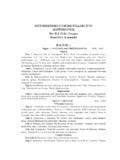Transcription of Step 5 – Lateral Capacity - Foundation …
1 Copyright 2003 Hubbell, Screw Foundation System Design Manual for New Construction Chance Company5-1 step 5 Lateral CapacityIntroductionThe primary function of a deep Foundation is to resist axial loads. In some cases, they willbe subjected to horizontal, or Lateral loads. Lateral loads may be from wind, seismicevents, live loads, water flow, etc. The resistance to Lateral loads is in part a function of thenear surface soil type and strength, and the effective projected area of the structurebearing against these soils. This section of the design manual presents a summarizeddescription of the methods and procedures available to determine the Lateral Capacity ofhelical screw foundations in soil. The analysis of deep foundations under Lateral loading iscomplicated because the soil reaction (resistance) at any point along the shaft is a functionof the deflection, which in turn is dependent on the soil resistance.
2 Therefore, solving forthe response of a deep Foundation under Lateral loading is one type of soil-structure-interaction problem best suited for numerical methods on a desktop Resistance Methods UsedIt is obvious that helical screw foundations have slender shafts which offer limitedresistance to Lateral loads that are applied perpendicular to its shaft. However, a largenumber of load tests have validated the concept that vertical pile foundations are capableof resisting Lateral loads via shear and bending. Two commonly used methods to analyzethe Lateral Capacity of pile foundations in soil is the finite difference method and the Broms method as outlined by Bengt B. Broms (1963). Lateral resistance can also be provided by passive earth pressure against the structuralelements of the Foundation . The resisting elements of the structure include the pile cap,grade beams, and stem walls.
3 The passive earth pressure against the structural elementscan be calculated using the Rankine screw foundations can be used to resist Lateral loads by assuming that thehorizontal load on the structure is resisted by components of the axial load. The implicitassumption in this is the battered foundations do not deflect laterally, which is not , it is better practice to use vertically installed screw foundations to resist onlyvertical loads and battered screw foundations to resist only Lateral resistance along the bottom of a footing, especially in the case of a continuousstrip footing or large pile cap, can be significant. The friction component in a sandy soil isFigure PilesFigure Earth Pressure ResistanceFigure ResistanceEnlarged ShaftSectionBending MomentDistribution in PileOptional Lateral TiebackGrade Beam & Pile CapPassive EarthPressure ResistanceBattered PilesPile Cap5-2 Copyright 2003 Hubbell, Screw Foundation System Design Manual for New Construction Chance Companysimply the structure s dead weight multiplied by the tangent of the angle of internalfriction.
4 In the case of clay, cohesion times the area of the footing may be used for thefriction component. When battered piles are used to prevent Lateral movement, thefriction may be included in the computation. The designer is advised to use caution whenusing friction for Lateral resistance. Some building codes do not permit friction resistanceunder pile supported footings and pile caps due to the possibility the soil will settle awayfrom the footing or pile cap. Shrink-swell soils, compressible strata, and liquefiable soilcan result in a void under footings and pile AssistanceIf required, the application engineers at Hubbell Power Systems/Chance can provideproject specific Lateral load response analysis - given sufficient data relating to the appliedloads and the soil profile. If you need engineering assistance, please contact the Hubbell/Chance CivilConstructionDistributor in your information forHubbell/Chance CivilConstructionDistributors can befound professionals willhelp you to collect thedata required to performlateral Plot of Deflection vs.
5 Depth LPILE PLUS Output Copyright 2003 Hubbell, Screw Foundation System Design Manual for New Construction Chance Company5-3 Lateral Analysis by Finite DifferencesSeveral computer programs, such as LPILEPLUS (ENSOFT, Austin, TX), are subsequentrevisions of the COM624 program (Matlock and Reese) and its predecessor Beam-Column28 (Matlock and Haliburton), which both use the p-y concept, soil resistance is a non-linear function of pile deflection, which was further developed by Poulos (1973). Thismethod is versatile and provides a practical means for design. This method is madepossible with computers for solving the governing nonlinear, fourth-order differentialequation, which is explained in greater detail in step 6. Lateral load analysis softwaregives the designer the tools necessary to evaluate the force-deflection behavior of a helicalscrew Foundation embedded in and b are sample LPILEPLUS output plots of Lateral shaft deflection andbending moment vs.
6 Depth where the top of the pile is fixed against rotation. From resultslike this, the designercan quickly determinethe Lateral response atvarious horizontal loadsup to the structurallimit of the pile whichis typically geotechnicalconsultants useLPILEPLUS or othersoil-structure-interaction programs topredict soil-pileresponse to Output of Bending Moment vs. Depth LPILEPLUS Output5-4 Copyright 2003 Hubbell, Screw Foundation System Design Manual for New Construction Chance CompanyLateral Analysis by Brom s MethodThe Broms method is best suited for applications where the top section of the helicalscrew Foundation is a greater diameter than the bottom section. Enlarged top sections arecommonly used to increase the Lateral Capacity of the Foundation shaft. Design gives an example of this. It uses the Broms method for short piers in cohesive soil.
7 A short pier is one that is rigid enough that it will move in the direction the load is tendingby rotation or translation. A long pier is one that the top will rotate or translate withoutmoving the bottom of the Foundation , a plastic hinge will developed Lateral Capacity methods for both short and long piles in cohesive andnon-cohesive soil. Broms theorized that a short free-headed pier rotates about a center,above the lower end of the Foundation , without substantial deformation along its axis. Theresistance is the sum of the net of the earth pressures above and the passive earthpressure below the center of rotation. The end bearing influence or effect is , the passive earth pressure on the uppermost diameters of shaft and theactive earth pressure on the back of the pile are neglected. Figure is a reaction/shear/moment diagram that demonstrates the Broms theory for laterally loaded short piles incohesive soils.
8 A simple static solution of these diagrams will yield the requiredembedment depth and shaft diameter of the top section required to resist the specifiedlateral load. It is recommended the designer obtain and review Broms technical papers(Reference items 2 and 3) to familiarize themselves with the various solution methods inboth cohesive and non-cohesive Brom s Method for Short Piles in Clay (Energy Structures, Inc., 1994) Copyright 2003 Hubbell, Screw Foundation System Design Manual for New Construction Chance Company5-5 Design Example Broms MethodA Type SS175 13 4" square shaft helical screw Foundation is proposed for a pedestrianbridge abutment. The top section of the shaft is to be encased in a 6" nominal steel pipeand grout to provide Lateral resistance. The top 10 feet of the soil profile is medium-stiffclay with cohesion of 1000 psf.
9 Determine what length of 6" diameter steel case is requiredto resist 4400 lb of Lateral load using the Broms :1. The 13 4" square shaft below the 6" cased section provides no Lateral The solution method used is as shown in Figure Eccentricity is assumed to be 1 Broms method is typically an iterative process best solved with a computerspreadsheet program. But for this example, the solution is :P = Applied Horizontal Shear Load: Use 4400 lb, Include a Factor of Safety of 2 in thecalculations, thus double the Horizontal Shear Load: P = 2 x 4400 = 8800 lbCu = Cohesion of Clay, use Cu = 1000 psfD = Diameter of Foundation ; Use D = " (6" nominal pipe size)e = Eccentricity; Distance Above Grade to Resolved Load: Use e = 1 ftL = Minimum Length of Foundation Based on Above = P/9(Cu)DEquation = 8800 (1000 psf)( "/12) = ftMPOS MAX = P[e + (D) + (f)]Equation MAX = 8800 lb[1 ft + ( "/12) + ( ft.)]
10 ] = 23,880 ft-lbMPOS MAX = (D)g2(Cu)Equation ,880 ft-lb = ( "/12)g2(1000 psf)g2 = ft2g = = ftL = + f + gEquation = ( "/12) + ft + ft. = ftThe 6" nominal steel case should be at least 7'-0 long to resist the 4400 lb Lateral Broms method was probably the most widely used method prior to the finitedifference and finite element methods used today and gives fair agreement with fieldresults for short Capacity by Battered Helical Screw Foundations and AnchorsLateral loads are commonly resolved with battered screw foundations and tension method is to statically resolve the axial load Capacity into its vertical and horizontalcomponents. As stated earlier, it is best to use vertically installed screw foundations toresist only vertical loads and battered screw foundations to resist only Lateral are some engineers who feel that battered piles in seismic areas attract seismicforces during an earthquake, and may therefore rupture.





